The NVIDIA GeForce GTX 780 Ti Review
by Ryan Smith on November 7, 2013 9:01 AM ESTOverclocking
Finally, let’s spend a bit of time looking at the overclocking prospects for the GTX 780 Ti. Although GTX 780 Ti is now the fastest GK110 part, based on what we've seen with GTX 780 and GTX Titan there should still be some headroom to play with. Meanwhile there will also be the matter of memory overclocking, as 7GHz GDDR5 on a 384-bit bus presents us with a new baseline that we haven't seen before.
| GeForce GTX 780 Ti Overclocking | ||||
| Stock | Overclocked | |||
| Core Clock | 876MHz | 1026MHz | ||
| Boost Clock | 928MHz | 1078MHz | ||
| Max Boost Clock | 1020MHz | 1169MHz | ||
| Memory Clock | 7GHz | 7.6GHz | ||
| Max Voltage | 1.187v | 1.187v | ||
Overall our overclock for the GTX 780 Ti is a bit on the low side compared to the other GTX 780 cards we’ve seen in the past, but not immensely so. With a GPU overclock of 150MHz, we’re able to push the base clock and maximum boost clocks ahead by 17% and 14% respectively, which should further extend NVIDIA’s performance lead by a similar amount.
Meanwhile the inability to unlock a higher boost bin through overvolting is somewhat disappointing, as this is the first time we’ve seen this happen. To be clear here GTX 780 Ti does support overvolting – our card offers up to another 75mV of voltage – however on closer examination our card doesn’t have a higher bin within reach; 75mV isn’t enough to reach the next validated bin. Apparently this is something that can happen with the way NVIDIA bins their chips and implements overvolting, though this the first time we’ve seen a card actually suffer from this. The end result is that it limits our ability to boost at the highest bins, as we’d normally have a bin or two unlocked to further increase the maximum boost clock.
As for memory overclocking, we were able to squeeze out a bit more out of our 7GHz GDDR5, pushing our memory clock 600MHz (9%) higher to 7.6GHz. Memory overclocking is always something of a roll of the dice, so it’s not clear here whether this is average or not for a GK110 setup with 7GHz GDDR5. Given the general drawbacks of a wider memory bus we wouldn’t be surprised if this was average, but at the same time in practice GK110 cards haven’t shown themselves to be as memory bandwidth limited as GK104 cards. So 9%, though a smaller gain than what we’ve seen on other cards, should still provide GTX 780 Ti with enough to keep the overclocked GPU well fed.
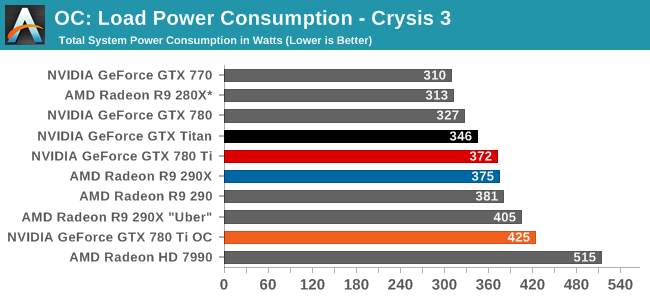
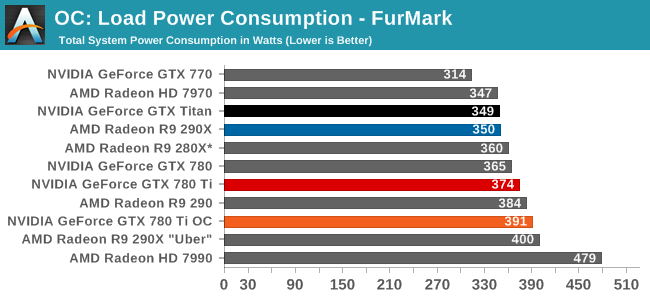
Starting as always with power, temperatures, and noise, we can see that overclocking GTX 780 Ti further increases its power consumption, and to roughly the same degree as what we’ve seen with GTX 780 and GTX Titan in the past. With a maximum TDP of just 106% (265W) the change isn’t so much that the card’s power limit has been significantly lifted – as indicated by FurMark – but rather raising the temperature limit virtually eliminates temperature throttling and as such allows the card to more frequently stay at its highest, most power hungry boost bins.
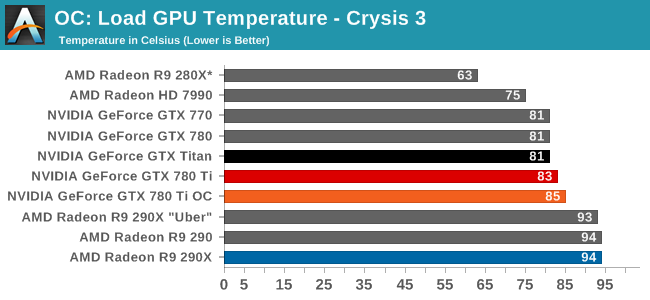

Despite the 95C temperature target we use for overclocking, the GTX 780 Ti finds its new equilibrium point at 85C. The fan will ramp up long before it allows us to get into the 90s.
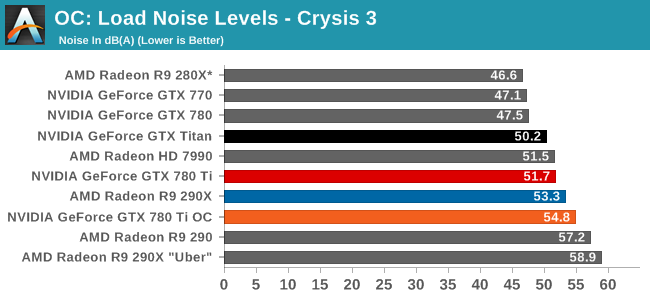
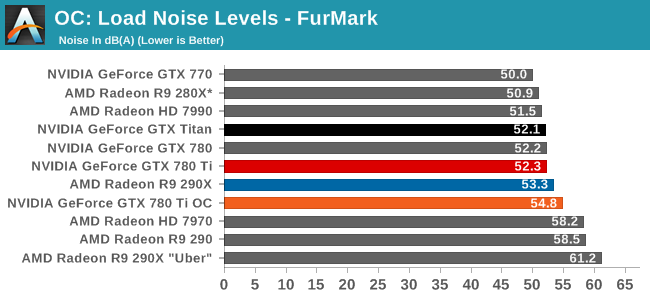
Given the power jump we saw with Crysis 3 the noise ramp up is surprisingly decent. A 3dB rise in noise is going to be noticeable, but even in these overclocked conditions it will avoid being an ear splitting change. To that end overclocking means we’re getting off of GK110’s standard noise efficiency curve just as it does for power, so the cost will almost always outpace the payoff on a relative basis.
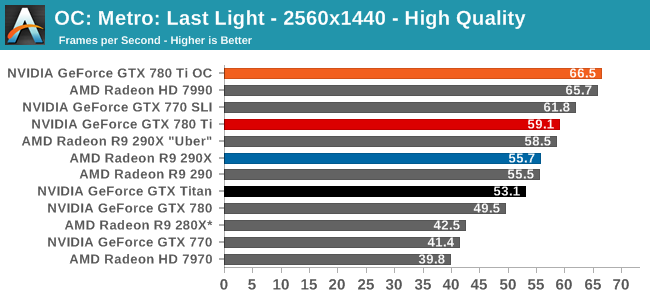
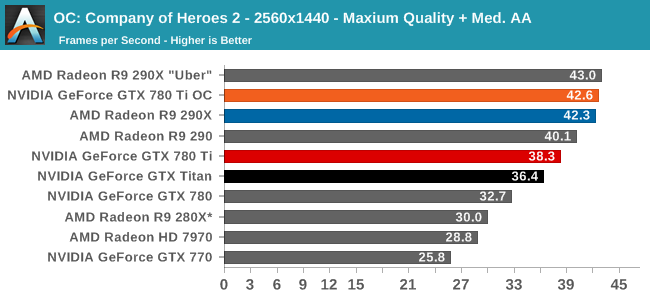
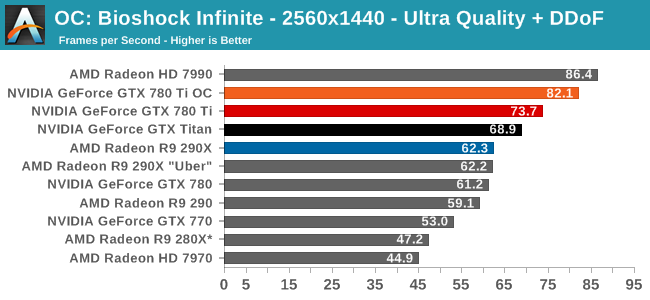
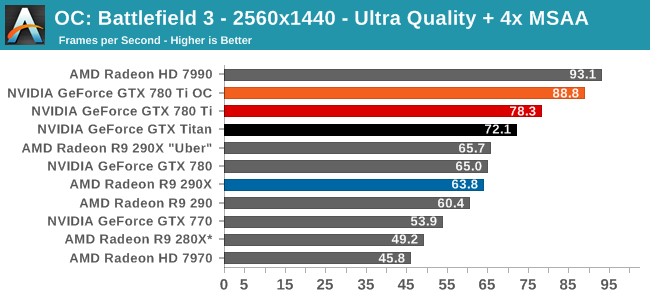
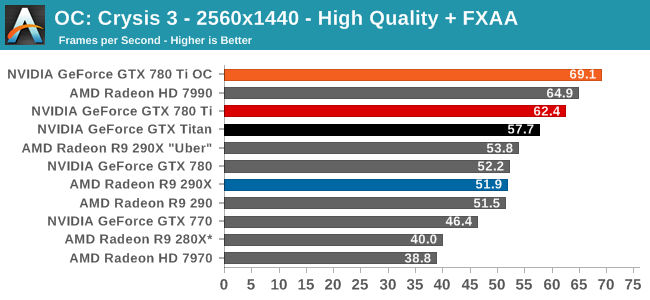
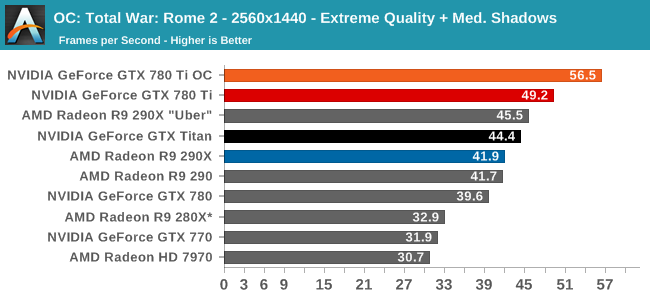
Finally, looking at gaming performance the the overall performance gains for overclocking are generally consistent. Between our 6 games we see a 10-14% performance increase, all in excess of the memory overclock and closely tracking the GPU overclock. GTX 780 Ti is already the fastest single-GPU card, so this only further improves its performance lead. But it does so while cutting into whatever is above it, be it the games where the stock 290X has a lead, or multi-GPU setups such as the 7990.










302 Comments
View All Comments
1Angelreloaded - Saturday, November 16, 2013 - link
False I Hit the 3.5 Gb limit quite a few times due to it being a 32 bit game, now if they are 64bit games then yes they will use more than 3GB for textures and draw distance , but meh you know what your talking about.......right.ahlan - Friday, November 8, 2013 - link
Damage control Nvidia fanboy! Nvidia fanboys are delusional as MS and Apple fanboys...Keep paying more for the same performance...
dylan522p - Thursday, November 7, 2013 - link
Not at all. In quiet more. It runs hotter, is louder 95% of the time and is using more power.dylan522p - Thursday, November 7, 2013 - link
And performs significantly worse.DMCalloway - Thursday, November 7, 2013 - link
Definition of upsetting: Early gtx 780 adopters now able to purchase a 'true' gtx 780 at the same price point previous gtx 780's were at launch. Nvidia sat back, took everyone's cash, and now to remain competitive finally release a fully enabled chip..... wowSpunjji - Thursday, November 7, 2013 - link
I think early adopters on both sides got dicked here. The R9 290 makes everything else look like a joke in terms of pricing, for all its manifest flaws.dylan522p - Thursday, November 7, 2013 - link
I would rather not have the 480v2, in my machine.Yojimbo - Thursday, November 7, 2013 - link
And next year they'll release something even faster at the same price point. You can't have both increasing performance/price over time and also not have your new hardware become a comparatively bad deal in the future. People who bought the GTX 780 when it came out got 5 to 6 months of use of the card in exchange for a card which is now ~15% slower than what's available at the same price point.ShieTar - Friday, November 8, 2013 - link
In other words: Nvidia did what absolutely every other CPU & GPU provider has also done over the last 30 years? Wow indeed.Everybody wants to bring the most profitable product possible to the market. That means, you need to be good enough to interest customers and cheap enough to be affordable. And you don't get better or cheaper, unless something changes the market, e.g. competition.
extide - Thursday, November 7, 2013 - link
You stated the 290x is "unable to compete with an older architecture." That is false. LOL